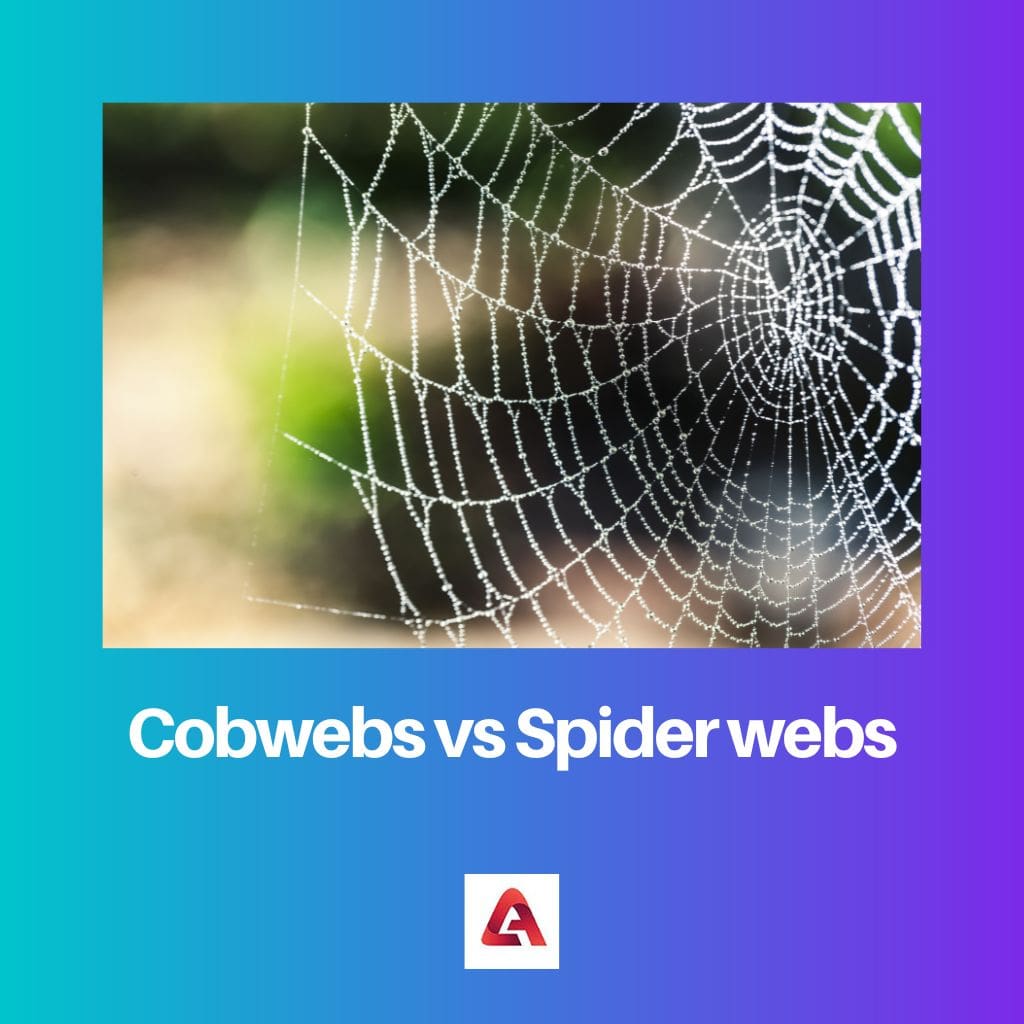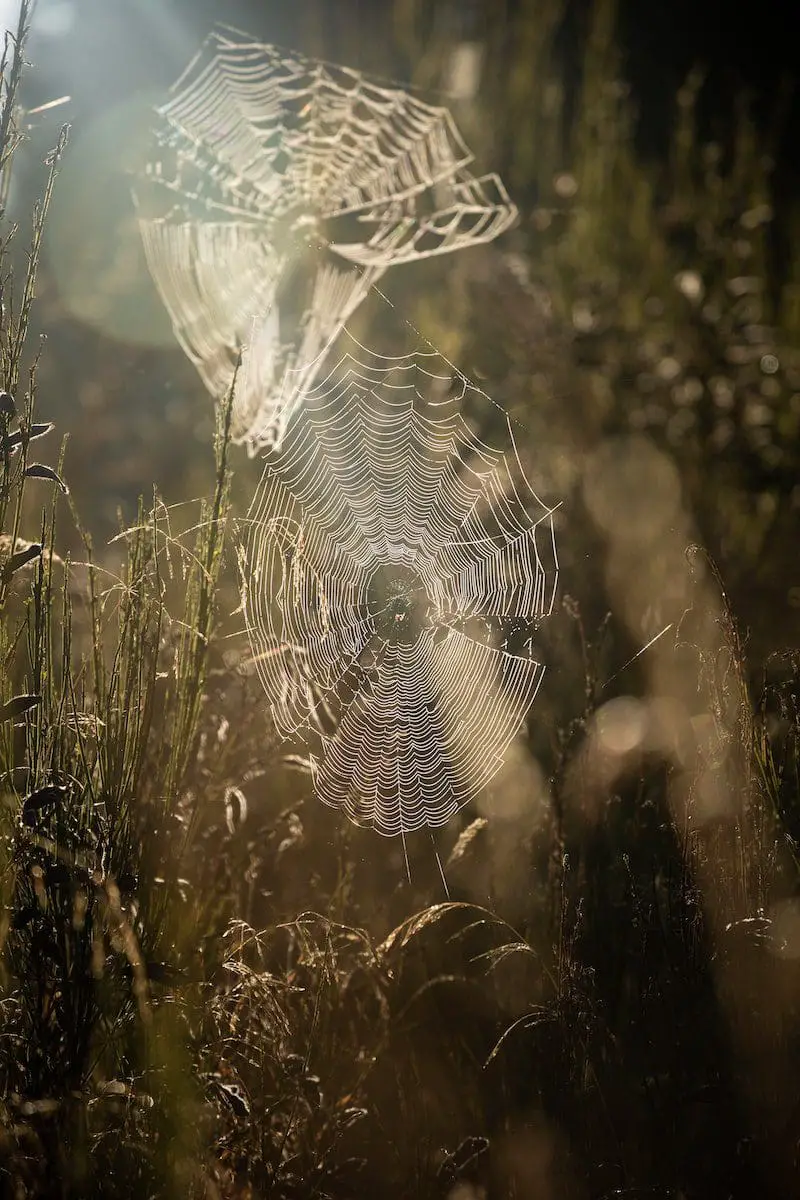Cobwebs and spider webs are structures spiders create, for catching prey. These are made with long continuous filaments of proteinaceous silk that extrude from a spider’s spinneret.
Spider silk is known to have a tensile strength that is almost equivalent to that of high-grade steel.
Key Takeaways
- Cobwebs are irregular, disorganized webs made by spiders from the family Theridiidae, and the term is also commonly used to describe abandoned, dusty spider webs.
- Spider webs are the intricate, organized structures spiders create to catch prey, offering various designs and patterns depending on the species.
- While both cobwebs and spider webs are silk structures made by spiders, cobwebs are associated with irregular, disorganized, or abandoned webs. In contrast, spider webs include various designs made by different spider species.
Cobwebs vs. Spider Webs
The difference between cobwebs and spider webs is that cobwebs are three-dimensional webs that look tangled, irregular, and gum-footed. In contrast, spider webs are symmetrical, sophisticated, and elegant-looking two-dimensional webs.

Different species make both webs of spiders. Cobwebs are specifically built by families of spiders, namely Theridiidae and Linyphiidae.
On the other hand, spider webs are spun by spiders grouped in the family Araneidae, Nephilidae, Tertagnathidae, and others.
In vernacular usage, the difference is that cobwebs are the webs the spider has abandoned while spider webs are still in use.
Comparison Table
| Parameters of Comparison | Cobwebs | Spider Webs |
|---|---|---|
| Structure | Tangled, irregular, and gum-footed webs that collect dust and dirt | Elegant, sophisticated, and simple-structured webs that look freshly made |
| Appearance | Three-dimensional | Two-dimensional |
| Design | Sheet webs and gum-footed webs (with great diversity in web architecture) | Sheet webs, spiral orb webs, funnel webs, tubular webs, and tent webs |
| Types of Silk | Major ampullate silk | One, three, or four types of silk, depending on the species of the spider |
| Function | Serve as nests, prey traps, and means of transport | Used for wrapping prey for later consumption, nesting, protecting an offspring, and also serving as a source of food |
| Producer | A family of spiders called Theridiidae (comb-footed spiders) and Linyphiidae (sheet weavers or money spiders) | Families of spiders such as Araneidae, Nephilidae, Tertagnathidae, and others |
| Location | Found indoors ( in corners that are isolated or not cleaned often) | Mostly found outdoors |
| Inhabitancy | Webs that spiders have abandoned. | Webs that are still in use. |
What are Cobwebs?
The word ‘cobweb’ was derived from the old English word ‘Coppe,’ which now translates to ‘spider.’ Cobwebs are tangled, irregular, and gum-footed three-dimensional webs found in isolated and dirty corners of closed spaces.
These are spun by spiders of the families Theridiidae (comb-footed spiders) and Linyphiidae (sheet weavers or money spiders).
Made of major ampullate silk, these webs serve as nests, prey traps, and means of transportation. A spider may also use cobwebs as launching pads to jump around the area, searching for prey.
In the 16th century, people of the Austrian Tyrolean Alps wove cobwebs together to create a paper on which they could paint. In other parts of the world, these webs were also used to heal cuts and wounds quickly.
The word cobweb also refers to a web abandoned by a spider. This happens when the availability of food is less.

What are Spider Webs?
Spider webs are symmetrical, elegant, and sophisticated webs that spiders of Araneidae, Nephilidae, Tertagnathidae, etc. spin. These webs are two-dimensional and are found outdoors.
Spider webs are spun in five patterns: spiral orb web, funnel web, tubular web, sheet web, and tent web. The silk used to make them could be of one, three, or four types, depending on the species of the spider.
Spiders’ two most common types of silks to make webs are viscid silk and dragline silk. Viscid silk is wet, elastic, and sticky. It is used to build the outer spirals of a spider web and to catch and wrap small insects.
Spiders may also extrude single strands of viscid silk as support while jumping from one place to another.
On the contrary, dragline silk is harsh, dry, and strong. A spider uses it to build the basic framework of a web. Dragline silk’s toughness provides structural stability to the web, allowing spiders and their offspring to nest in it.
Spider webs help clot blood as they are enriched with vitamin K. Due to this virtue, they were used in olden times to stop a wound from bleeding.
Spider webs are distinguished as those that spiders still use.

Main Differences Between Cobwebs and Spider Webs
- Cobwebs are tangled, irregular, and gum-footed, while spider webs are symmetrical, elegant, and sophisticated.
- The Theridiidae and Linyphiidae families produce cobwebs, while spiders of Araneidae, Nephilidae, Tertagnathidae, etc., produce spider webs.
- The architecture of cobwebs is three-dimensional, while spider webs are two-dimensional.
- Cobwebs have a diverse variety of architectural designs, the primary design being gum-footed and tangled webs. On the contrary, spider webs can be of five different designs.
- Cobwebs are made of major ampullate silk, while spider webs can be made from one to four different types of silk depending upon the spider species.
- Cobwebs are found indoors, while spider webs are found outdoors.
- In vernacular usage, cobwebs are those webs that the spider has abandoned, while spider webs are those that are still in use.



